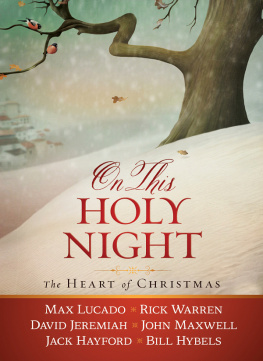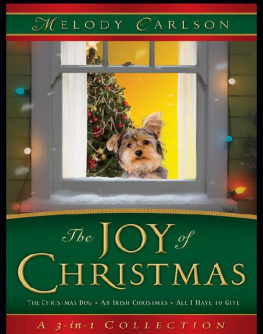Margaret Barker is an independent scholar, a Methodist local preacher and a former President of the Society for Old Testament Study. She has developed Temple Theology as a new approach to biblical studies, and was given a DD for her work on the temple and the origins of Christian liturgy. For many years, she has been a member of the Ecumenical Patriarchs Symposium on Religion, Science and the Environment, and has made Temple Theology the basis for her work on the environment. This is her fourteenth book, reading the Christmas stories as Temple Theology.
Her recent books include: Temple Themes in Christian Worship (2008), The Hidden Tradition of the Kingdom of God (2007), Temple Theology (2004), An Extraordinary Gathering of Angels (2004), The Great High Priest (2003) and The Revelation of Jesus Christ (2000).
First published in Great Britain in 2008
Society for Promoting Christian Knowledge
36 Causton Street
London SW1P 4ST
www.spckpublishing.co.uk
Copyright (c) Margaret Barker 2008
All rights reserved. No part of this book may be reproduced or transmitted in any form or by any means, electronic or mechanical, including photocopying, recording, or by any information storage and retrieval system, without permission in writing from the publisher.
SPCK does not necessarily endorse the individual views contained in its publications.
The publisher and author acknowledge with thanks that the Abdullah Yusuf Ali Translation of The Holy Quran is used by kind permission of Islamic Vision, Birmingham.
Unless otherwise noted, Scripture quotations are from the Revised Standard Version of the Bible, copyright (c) 1946, 1952 and 1971 by the Division of Christian Education of the National Council of the Churches of Christ in the USA. Used by permission. All rights reserved.
Extracts from the Authorized Version (AV) of the Bible (The King James Bible), the rights in which are vested in the Crown, are reproduced by permission of the Crowns Patentee, Cambridge University Press.
Scriptures quoted from the Good News Bible (GNB) published by The Bible Societies/HarperCollins Publishers Ltd UK, (c) American Bible Society, 1966, 1971, 1976, 1992, 1994, are used by permission.
Extracts from The Book of Common Prayer, the rights in which are vested in the Crown, are reproduced by permission of the Crowns Patentee, Cambridge University Press.
Every effort has been made to acknowledge fully the sources of material reproduced in this book. The publisher apologizes for any omissions that may remain and, if notified, will ensure that full acknowledgements are made in a subsequent edition.
British Library Cataloguing-in-Publication Data
A catalogue record for this book is available from the British Library
ISBN 9780281060504
3 5 7 9 10 8 6 4 2
Typeset and eBook by Graphicraft Ltd, Hong Kong
Printed in Great Britain by Ashford Colour Press
Subsequent digital printing in Great Britain by Ashford Colour Press
Produced on paper from sustainable forests
In memory of
David Melling
who died in September 2004
The people who walked in darkness have seen a great light;
those who dwelt in a land of deep darkness, on them has light shined.
Isaiah 9.2
Lighten our darkness, we beseech thee, O Lord; and by thy great mercy defend us from all perils and dangers of this night;
for the love of thy only Son, our Saviour Jesus Christ.
Collect for Aid against all Perils Book of Common Prayer
Contents
For many years I have been leading pre-Christmas study days: Exploring the Christmas Stories. These looked at the well-known texts in the New Testament, and then at the less well-known, such as the Infancy Gospel of James , the Arabic Infancy Gospel , and the Quran. Eventually they became this book.
The great festivals of the Church have been almost taken over by supermarkets and sporting events. Easter is a time for bonnets and bunnies and chocolate eggs; Christmas, which starts at the end of October, is for reindeer and mistletoe and mince pies. Nativity plays have come a long way since St Francis first set up his crib. Either they are banned to satisfy the politically correct, or they are modern and have the birth in a bus shelter, or they are sentimental and have squirrels and even sea creatures at the crib.
The original story is so much better. It has suffered from overfamiliarity, and the words are sometimes lost in a flurry of domestic distraction. Reread and repondered, the original story of the incarnation is one of the greatest treasures in the Bible.
I dedicate this book to the memory of a dear friend, who shared my love for the ancient traditions of the Church.
Margaret Barker
Easter 2008
The Christmas stories are not only beautiful; their meaning is at the heart of the Christian faith, and they show how the first generations expressed their understanding of Jesus as both God and man. The creeds are later statements of Christian belief, summarizing the essentials. The first to be set out formally was the Apostles Creed, the declaration made before baptism in the Western churches which was in use in Rome at the beginning of the third century.
The other creed most familiar to Christians is the Nicene Creed, recited at the Eucharist in churches of both Eastern and Western traditions. It was probably developed from a baptismal creed used in Palestine, was adopted by the Council of Nicaea in 325 CE, and expanded by the Council of Constantinople in 381 CE. The precise history of its development is complex. Like the Apostles Creed, it lists as essentials of the faith only the teachings about the birth and death of Jesus. Of Christmas it says: One Lord Jesus Christ, the only-begotten Son of God, begotten of His Father before all worlds, God of God, Light of Light, Very God of very God, Begotten not made, Being of one substance with the Father, By whom all things were made: Who for us men and our salvation came down from heaven, And was incarnate by the Holy Ghost of the Virgin Mary, And was made man .... This is the theology of the Christmas story, but it is in two stages. There is the only-begotten Son of God, begotten of his Father before all worlds, and there is the Son of God who became incarnate of the Virgin Mary.
Christians have always been careful to remember and distinguish the two births. The Orthodox Church calls Christmas the Nativity according to the flesh, a constant reminder of the other birth. Augustine, who died in 430 CE, summarized this in a Christmas sermon:
Our LORD Jesus Christ, the Son of Man as well as the Son of God, born of the Father without a Mother, created all days. By his birth from a Mother without a Father, he consecrated this day. In his divine birth he was invisible; in his human birth, visible; in both births, awe-inspiring.
Both births are found in the New Testament: the Son of God was born in eternity, beyond our understanding, as John wrote in the prologue to his Gospel: In the beginning was the Word ... (John 1.1). The Son of God became incarnate with the Bethlehem birth the Virgin birth, and of this birth John wrote: the Word became flesh and dwelt among us (John 1.14). The Christmas story does not describe the birth of the Son of God; it describes the incarnation of the Son of God who was born in eternity . Throughout any exploration of the Christmas story there is the problem of words with a special meaning that differs from their normal use. If this mystical element is not recognized, the result can be a literalism that, far from being faithful to the fundamentals of the story, in fact distorts it.
















